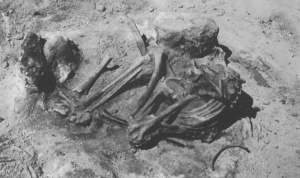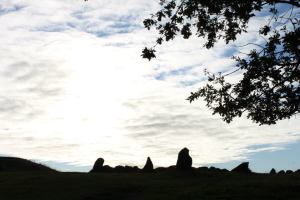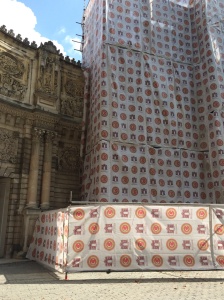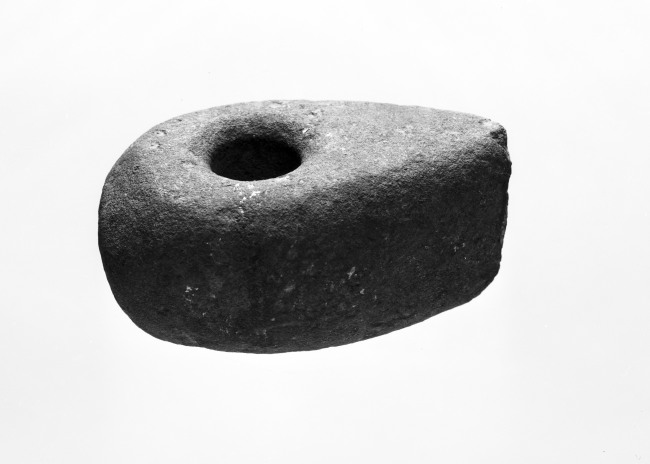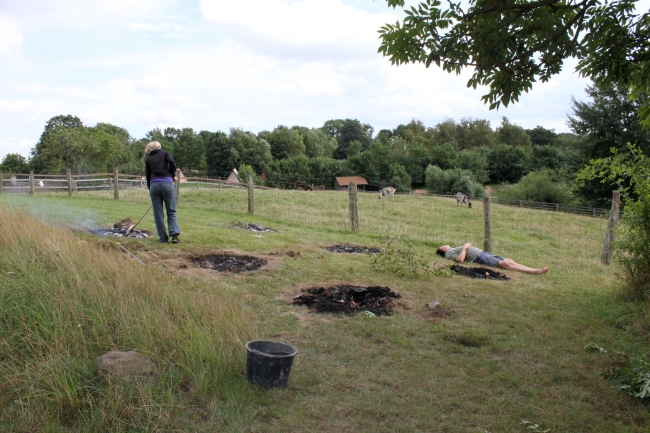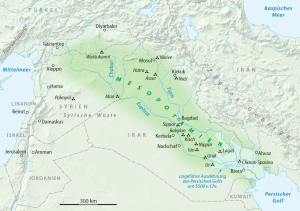Recently, I started researching gender representation in presentations of Vikings in modern movies. This has lead me to watch quite a few films of varying quality about the Viking Age (in Norway ca 800-1000), which I have both enjoyed (e.g. Ragnarokk (2013) – a Norwegian production about an archaeologist on expedition to find Viking treasure) and ridiculed (The Northmen (2014) – a German/European production about the bloody Viking raids starring 20 muscular male superheroes and 1 excessively pretty woman). However, I realise now had not yet been offended. After all, we are talking about my past here. As the only Scandinavian in the project, I guess I was the only one with the potential of having deeply personal feelings linked to each and every movie, although there are some quite “eh” presentations of the British as well. Nevertheless, my British colleague and I never seriously discussed this issue.
Enter VIKINGS. A recent series produced by the History Channel (more info: http://www.imdb.com/title/tt2306299/?ref_=nv_sr_1). As that network had been involved, it could possibly be expected to have enlisted a number of consultants for its production. In either case, we had heard it was horrifying with regards to gender, and none of our collaboration of 4 adult social science researchers wanted to take it on. We agreed to watch the first two episodes together in solidarity. Since we were looking at gender specifically, we had a set of questions that we wanted to answer. It was hard to provide any in-depth answer, and sometimes even a simple yes/no could not be found, as it was expected to develop throughout the series. Since I had gotten the series out of the library, I took it home and continued watching it.
The gender representation will be presented elsewhere (and come hear our talk on Sat 5th of September at the EAA in Glasgow!), I will only state here that after nearly two seasons there are 3 significant female roles, 4 if you count a girlfriend role that never acts without her boyfriend in the scene. In comparison, the number of significant male roles are 10. All in all that makes for 23,1 % significant women compared to men. We also see an astounding number of men in comparison to women in total. Biologically, there is about 50/50 in any population, to secure the survival of the species. I am sure the Viking women were as crucial to the society structure then as women have been since.
Nevermind the gender issue, VIKINGS was not bad considering other recent productions. It includes quite a significant number of archaeological findings (for instance the temple at Uppsala, the animal sacrifices, and the potential for human sacrifices sprung off the earlier Nerthus-cult, and features of the settlement both inside and out), however much spectacularised. This was of course to be expected, but nonetheless I was not a sworn hater yet. I did find the use of violence excessive, but I could handle it. After all, this was a feature of most Viking films, especially non-Scandinavian productions. Also, taking an analytical viewpoint kept me from getting too engrossed, and I was actually looking at the battle scenes with an eye for social or archaeological detail. But then came the turning point.
A lot of the series relies heavily on Ibn Fadlan’s Risala chronicles from his journey c. 921. He describes a people he calls Rusiyyah in such detail that most scholars agree that he talks about Scandinavian settlers along the Volga (see Montgomery 2000 for a translation of the account). There is reference to a human sacrifice that may or may not be something called the “blood eagle” in other sources of literature. At this point, it is important to state just how unreliable these texts are considered in Norwegian archaeological education. None is without deep issues of source criticism, for instance fantastic descriptions and what that really meant at the time (Phelpstead 2012) or the fact that none of the texts originate from the cultures in question. Instead either insulted and angry British authors, later christian monks, or outside viewers from far away penned the few written references we do have (Montgomery 2000: 23 and note 4).
In other words, the existence of the so-called blood-eagle technique, which is supposed to be a horrid execution method that you would today not even associate with ISIS, is dubious to say the least. The technique itself is considered to include amongst others a separation of the ribs from the back in an outward manner, but I will not go into further detail – it can be easily found in popular entries on the web, and in Orkneyjar saga verse 8, penned in the 1200s by christian scholars. Montgomery’s translation of Ibn Fadlan only describes the relevant passage as “She [the executioner/shaman/volve] advanced with a broad-bladed dagger and began to thrust it in and out between her ribs, now here, now there” – in other words not very specific at all. My one hour search session on Google Scholar reveals that archaeological discussions of this technique are hard to come by, and that most, if not all of the authors that do discuss it are not Scandinavian. Even more interesting: A search in Scandinavian languages give only 3 hits on Scholar, and the most recent one is from 1878…
Needless to say, Scandinavian archaeologists and general public do not associate the Vikings with this horrible maybe-procedure, rather we are presented a view of the Vikings as mariners, farmers, craftspeople and warriors, yes, but never pirates. We get introduced to their daily life in school, we visit museums and look at their beautiful crafts, like the astonishing ships, we have to go through grueling language history including Norse grammar, and we laugh at/with them in one of our favourite cartoons, Hägar the Horrible (Norwegian: Hårek den Hardbalne; literally Hårek the hard-balled). They are a deep and foundational part of our history. In Norway the Vikings are considered to have started the final collation of the nation, and it is probably not overstating it to say that we are proud of them.
 Hårek: An American comic about the Vikings. We still laugh. Source: Chris Browne
Hårek: An American comic about the Vikings. We still laugh. Source: Chris Browne
Even more so, Scandinavian archaeologists are seen as one of the main factors in the generation of knowledge about the Viking Age. To a certain extent, I think most of us know quite a lot about them, both through our interest in old things, but also through our general schooling in archaeology. Certainly, a Scandinavian field archaeologist will gain quite an extensive knowledge, as we dig a significant number of Viking Age sites. I, personally, did my BA specialisation in Iron Age and the Middle Ages, worked as a guide at a Viking village site, and have parttaken in quite a number of Viking Age digs. I was apprehensive to say the least, how I would react to the archaeological side of the movie-project. I already knew from having moved to the UK that “Vikings” and “Vikings” are two different things. My usual argument “the Vikings were farmers” never hit home, and even my archaeologist friends did not fully understand what I meant. Especially in the UK, the raiding Vikings are a big deal, and are described in negative terms, not as explorers (now, pause and think about their later description of themselves in the colonisation process of Asia and Africa…).
So, I watched VIKINGS. I watched, and I watched, and took notes and eventually it all became quite repetitive, so I decided to finish off a knitting project to entertain myself. I was deep in fastening threads when I heard very solemn music, and I realised that the execution scene that had been the big focus of the episode through unbearable description and such was about to happen. I decided I knew enough, so I didn’t look up until quite a few minutes had passed. By this time, the music had been going on for a while, and I thought the producer might angle the scene as tasteful as they had been with other excessively violent scenes, where they had more indicated than detailed the acts (for instance a human sacrifice scene where they only shot very limited views of flesh and knives). The views that met me were absolutely terrible, and I was completely unprepared for my reaction towards it. I am not going to describe the scene, I am sure a youtube video can detail it for you if you wish to see. But in my head, all I could hear was “We have no archaeological sources!!! These guys were not bad guys!! These guys were ME.”
This experience was a shock to me. After all, I am not one of those archaeologists who wanted to become an archaeologist since childhood (and I would estimate at least half of us wanted to). Given, I always had a special interest in the past, and that I in fact know a lot about Vikings, both from nationality and education, but I have never felt strongly about my own cultural history before. Even on excavation I always felt very distant from the people we were investigating, sitting on top of their remains. But it struck me so strongly with VIKINGS – they had taken something that was mine and made it theirs, and I was completely opposed to it.
 Digging the Vikings: more or less what my normal relationship with Vikings is like. Photo: Tore Stensvold/tu.no
Digging the Vikings: more or less what my normal relationship with Vikings is like. Photo: Tore Stensvold/tu.no
I discussed my emotions with a friend in the project, and she said it was a good thing. We both agreed it was useful to have those feelings now: Coincidentally, I am also writing a proposal for a research project that plans an excavation from the time around 1880. This is a time where local people alive might still remember people that lived then, and I cannot imagine what their feelings must be like. Or – I can image, and their feelings must be so much stronger than mine were. It is the responsibility of people telling stories about the past to be mindful of feelings, and I think we, as archaeologists, often approach it in such a disinterested way that it can in fact be disrespectful to the people that encircle our research. I will state here that I think it is our ethical duty to be aware. After all, it is often not our own past, and we are dealing with the identity of others (and for an interesting read on engaging with non-archaeological producers of the past, have a look at Thomas 2015). It is important that we understand that the significance of heritage differs vastly in professional environments and amongst the people that it concerns (and of course people whom it does not really concern, too).
The Vikings have morphed from my inheritance into the heritage of the world, to do with as they please. The Vikings are no longer considered actual, Scandinavian human beings, but have been re-inherited* to form mythical berserks, excessively violent warriors, raiding, pillaging, hurting others, with abhorring rituals, a cosmology like a fairytale and an extraterrestrial beauty and power. They are no longer mine, yet I mourn them like I never thought I would.
* Check out this blog post for more on re-inheritance of cultural heritage
BIBLIOGRAPHY
Montgomery, James E.
2000. Ibn Fadlan and the Rusiyyah. Journal of Arabic and Islamic Studies 31–25.
Phelpstead, Carl.
2012. Fantasy and history. The limits of plausibility in Oddr Snorrason’s Óláfs saga Tryggvasonar. SAGA-BOOK XXXVI27–42.
Thomas, Suzie.
2015. Collaborate, Condemn, or Ignore? Responding to Non-Archaeological Approaches to Archaeological Heritage. European Journal of Archaeology Eur. J. Archaeol. 18(2): 312–335.

